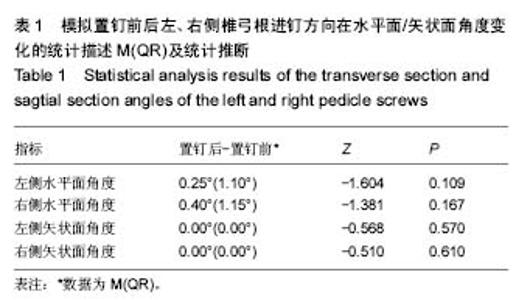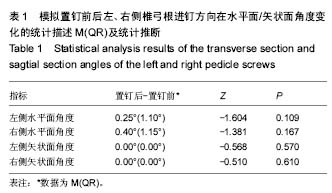| [1] 陈文,赵继荣,杨镇源,等.椎弓根螺钉植入技术的研究近况[J].中医临床研究,2016,8(14):141-144. [2] Fuster S, Vega A, Barrios G, et al. Accuracy of pedicle screw insertion in the thoracolumbar spine using image-guided navigation. Neurocirugia (Astur). 2010;21(4): 306-311.[3] Bergeson RK, Schwend RM, DeLucia T, et al. How accurately do novice surgeons place thoracic pedicle screws with the free hand technique. Spine. 2008;33(15): 501-507.[4] Upendra BN, Meena D, Chowdhury B, et al. Outcome-based classification for assessment of thoracic pedicular Screw placement. Spine. 2008;33(4):384-390.[5] Lu S, Zhang YZ, Wang Z, et al. Accuracy and efficacy of thoracic pedicle screws in scoliosis with patient-specific drill template. Med Biol Eng Comput. 2012;50(7):751-758.[6] Smorgick Y, Millgram MA, Anekstein Y, et al. Accuracy and safety of thoracic pedicle screw placement in spinal deformities. Spinal Disord Tech. 2005;18(6): 522-526.[7] 毛克政,王庆德,梅伟,等.3D打印个体化导板辅助颈椎椎弓根螺钉置钉的可行性研究[J].中华创伤杂志,2016,32(1):47-50.[8] 钟世镇,方驰华.三维打印技术的临床应用[J].中华外科杂志, 2016,54(9):658-660.[9] Tian NF, Huang QS, Zhou P, et al. Pedicle screw insertion accuracy with different assisted methods: a systematic review and meta-analysis of comparative studies. Eur Spine J.2011 20(6):846-859.[10] Gelalis ID, Paschos NK, Pakos EE, et al. Accuracy of pedicle screw placement: a systematic review of prospective in vivo studies comparing free hand fluoroscopy guidance and navigation techniques. Eur spine J.2012;21(2):247-255. [11] Weinstein JN, Rydevik BL, Rauschning W. Anatomic and tech-nical considerations of pedicle screw fixation. Clin Orthop Relat Res. 1992;284:34-46.[12] Lu S,Xu YQ,Chen GP,et al. Efficacy and accuracy of a novel rapid prototyping drill template for cervical pedicle screw placement. Comput Aided Surg. 2011;16(5):240-248.[13] Ryken TC,Owen BD,Christensen GE,et al. Image-based drill templates for cervical pedicle screw placement. J Neurosurg Spine. 2009;10(1):21-26.[14] Foley KT,Simon DA,Rampersaud YR.Virtua fluoroscopy: computer-assisted fluoroscopic navigation. Spine(Phila Pa 1976). 2001;26(4):347-351.[15] 陈玉兵,陆声,徐永清.个体化导航模板在胸椎椎弓根螺钉置入中的初步临床应[J].中国脊柱脊髓杂志, 2011, 21(8): 669-674.[16] 杨敬, 杜心如.如何确定腰椎“人”字嵴顶点的三维 CT 影像解剖学研究[J].中国临床解剖学杂志, 2013,1(1):79-81.[17] Lu S,Xu YQ,Zhang YZ,et al. A novel computer•assisted drill guide template for placement of C2 laminar screws. Eur Spine J. 2009;18(9):1379-1385.[18] 林海滨,张国栋,陈宣煌,等.3D打印导航模块辅助腰椎弓根螺钉数字化置入的实验精度[J].解剖学杂志,2016,39(4):459-464.[19] Fuster S, Vega A, Barrios G, et al. Accuracy of pedicle screw insertion in the thoracolumbar spine using image-guided navigation. Neurocirugia (Astur). 2010;21(4): 306-311.[20] 王燎, 戴尅戎. 骨科个体化治疗与3D打印技术[J].医用生物力学,2014,29(3):193-199.[21] 张斌,谭军.钉棒系统导向模板在脊柱外科中的应用进展[J]. 同济大学学报(医学版),2016,37(5):124-127.[22] 蔡斌,张文捷,赵春明,等. 经皮椎弓根螺钉置入安全性的CT评价[J].实用骨科杂志,2015,21(8):727-731.[23] Vishal Sarwahi MD,Stephen F,Wendolowski BS, et al. Are we underestimating the significance of pedicle Screw misplacement? Spine. 2016;41(9):548-555.[24] Owen BD,Christensen GE,Reinhardt JM,et al.Rapid prototype patient-specific drill template for cervical pedicle screw placement. Comput Aided Surg. 2007;12(5):303-308.[25] Ryken TC,Kim J,Owen BD,et al.Engineering patient-specific drill templates and bioabsorbable cervical plates:a feasibility study. J Neurosurg Spine. 2009;10(2):129-132.[26] 李忠海,唐家广,王华东.3D打印技术在骨科临床教学中的应用初探[J].中国医学教育技术,2016,30(2):198-200.[27] 邓滨, 欧阳汉斌, 黄文华.3D打印在医学领域的应用进展[J].中国医学物理学杂志,2016,33(4):389-392.[28] 陈文,赵继荣,杨镇源,等.椎弓根螺钉植入技术的研究近况[J].中医临床研究,2016,8(14):141-144.[29] 王博亮,蔡明,郭晓曦,等.数字医学在精准骨科手术中的应用[J].厦门大学学报(自然科学版),2013,52(2):202-205.[30] 王岩.骨科精准医疗:应用与思考[J].中华医学杂志,2015,95(31): 2512-2514.[31] 袁振山,胡勇.3D打印导向模板辅助置钉技术在寰枢椎后路内固定中应用的研究进展[J].中华创伤杂志,2016,32(1):51-54.[32] 尹庆水,王建华.3D打印技术给脊柱外科领域带来的变革[J].中华创伤杂志,2016,32(1):7-9.[33] Chen H, Guo K, Yang H, et al. Thoracic Pedicle Screw Placement Guide Plate Produced by Three-Dimensional (3-D) Laser Printing.Med Sci Monit. 2016;22:1682-1686.[34] Chen H, Wu D, Yang H, et al. Clinical Use of 3D Printing Guide Plate in Posterior Lumbar Pedicle Screw Fixation.Med Sci Monit. 2015;21:3948-3954.[35] Choy WJ, Mobbs RJ, Wilcox B, et al. Reconstruction of the thoracic spine using a personalized 3D-printed vertebral body in an adolescent with a T9 primary bone tumour: case report. World Neurosurg. 2017. pii: S1878-8750(17)30835-5. [36] Gao F, Wang Q, Liu C, et al. Individualized 3D printed model-assisted posterior screw fixation for the treatment of craniovertebral junction abnormality: a retrospective study. J Neurosurg Spine. 2017:1-6. [37] Bundoc RC, Delgado GG, Grozman SA. A Novel Patient-Specific Drill Guide Template for Pedicle Screw Insertion into the Subaxial Cervical Spine Utilizing Stereolithographic Modelling: An In Vitro Study. Asian Spine J. 2017;11(1):4-14. [38] Guo F, Dai J, Zhang J, et al. Individualized 3D printing navigation template for pedicle screw fixation in upper cervical spine. PLoS One. 2017;12(2):e0171509. [39] Golab A, Smektala T, Kaczmarek K, et al. Laparoscopic Partial Nephrectomy Supported by Training Involving Personalized Silicone Replica Poured in Three-Dimensional Printed Casting Mold. J Laparoendosc Adv Surg Tech A. 2017;27(4):420-422. [40] Liu K, Zhang Q, Li X, et al. Preliminary application of a multi-level 3D printing drill guide template for pedicle screw placement in severe and rigid scoliosis. Eur Spine J. 2017; 26(6):1684-1689. [41] Guenette JP, Himes N, Giannopoulos AA, et al. Computer-Based Vertebral Tumor Cryoablation Planning and Procedure Simulation Involving Two Cases Using MRI-Visible 3D Printing and Advanced Visualization. AJR Am J Roentgenol. 2016;207(5):1128-1131. |

